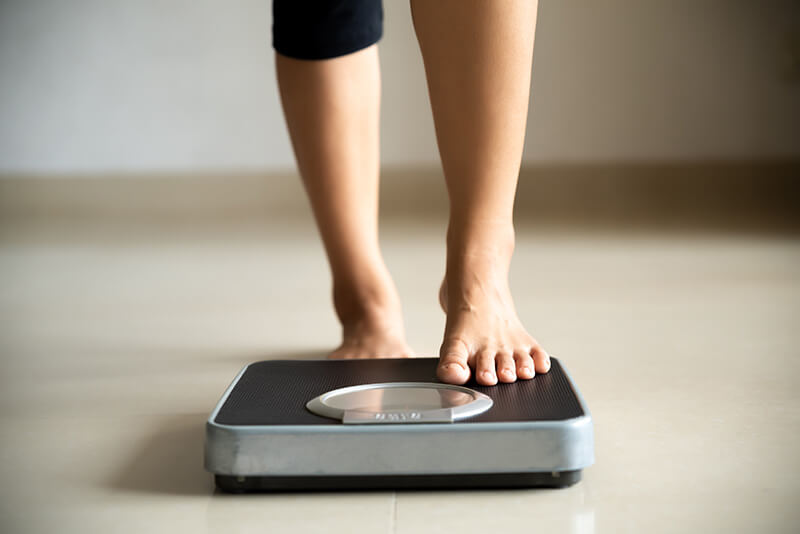In a world where pretty much everything is at our fingertips at lightning speed, our want for instant weightloss is no exception. Our access to information via our smartphones is great, and with so many apps to track our weightloss progress, losing weight has gotten easier.
However, the ability to lose weight as quickly as we conduct a Google search isn’t quite possible (sorry!). Unfortunately, if a diet promises weightloss overnight, it’s most likely too good to be true.
These trendy diets don’t last for long, and often leave you feeling hungry, potentially unhealthy and in the mindset to give up and pile pounds back on.
When it comes to shedding a few extra pounds, it’s more than just a decent diet plan, but your mindset matters too.
But how much weight can you lose safely in a month? What’s the magic number of weightloss each week?
We take a closer look.
Losing weight healthily

When you examine the mathematics associated with losing weight, it appears quite simple in black and white. We know we need to consume fewer calories than the amount we burn, pushing our bodies to burn fat we had otherwise been storing.
Naturally, as we all know, life gets in the way. Whether it’s social occasions, holidays, or a celebration that simply needs lots of food and treats.
But in order to lose weight and keep it off, it takes a long term strategy. This is where fad diets fall down. Creating a weightloss plan based on healthy eating and consistent exercise will not only make you healthier, but it’ll also help you lost weight and keep it off.
Setting realistics goals will help keep you on track to a healthier you – going beyond your goals of fitting in that little black dress once again.
Ensure you add some variety into your workouts, to maintain your interest. When we fall into the trap of repeating one workout, it’s easy to become bored and fall out of love with our goals. The combination of healthy eating habits and exercise will not only improve your health, but also rejuvenate your mindset towards food.
Adding a little strength training into the mix will help you to continue burning calories after your workout, as well as tone up. While bodyweight exercises are easy to do just about anywhere, and are great for switching up with high intensity interval training to give your metabolism the boost it needs.
Also Read: How To Get Back On Track With Weight Loss in 2021
Since we’re talking about getting healthier and losing weight in a healthy manner, the good news is you’ll actually begin to see positive changes sooner than you think. According to studies, if you’re overweight, losing 5-10% of your bodyweight can improve cholesterol, blood pressure and reduce your risk of diabetes.
Avoiding yo-yo dieting

The trouble with ‘dieting’ is that many of us view this new lifestyle as temporary. And when we go back to our old eating habits, the weight simply piles back on!
Depriving yourself of certain foods isn’t a sustainable way to live, making falling off the diet wagon very, very easy. When you lose weight incredibly quickly, your body is shocked by this sudden weightloss – making it difficult to maintain each month.
Whereas, when you introduce weightloss slowly and steadily, our bodies have more time to adjust and react to this new way of living. But instead of the yo-yo effect of on-off dieting, losing weight (and keeping it off) is all about our relationship with food.
How much weight can you safely lose in a month?
With 3,500 calories equalling one pound of fat, if you’re looking to burn a pound a week you’ll need to be cutting 500 to 1,000 calories out of your existing diet.
According to research, the magic number for losing (and maintaining weightloss) is 1 to 2 pounds each week. This means that you can safely lose 4 to 8 pounds per month.
Fad diets make fast weightloss feel super easy – which makes the whole diet itself pretty tempting! Initially, during these diets, you may lose more in the starting weeks. However, this can then be even more difficult to maintain thereafter, nor is it particularly healthy.
So, if you’re wondering how much weight can you lose in a month, 4 to 8 pounds is a healthy goal to aim for. Although there are some diets and healthy lifestyles you can follow that may equate to higher weightloss.
Understanding the right ‘diet’

When you have a different approach to food, having the odd treat instead of every treat allows you to enjoy meals without going overboard.
However, that doesn’t mean you need to restrict yourself completely.
Also Read: Bodyweight workouts that you can do anywhere
Intermittent fasting and keto are both incredibly popular amongst women who want to lose weight and transform their health and bodies. But what are the benefits?
Losing weight on the keto diet
Many women wonder, ‘does the keto diet really work?’ and with so many transformation photos shared online, it comes as no surprise that keto remains incredibly popular.
But just how effective is keto for weightloss? Well, the results can depend on the individual and their circumstances, with no one-size-fits-all results. There are some factors that can determine how much you lose and how fast you lose weight, including:
- Your body fat %, weight and gender
- Metabolic rate (slow/fast etc)
- Health conditions
- How “cleanly” you choose to eat
- How often you cheat
- How much energy you can maintain for daily activities
How much weight can you lose in a month on keto?

For many, keto is a lifestyle, not just a one-off diet. The amount of weight you can lose on keto can vary greatly from one person to another. Results can also vary depending how much weight you have to lose.
Let’s look at it this way…
On a ‘normal’ diet, consisting of a calorie deficit and regular exercise, most of us can expect to see a loss of one to two pounds each week. While on keto, this can be anywhere between two and ten pounds.
Woah, that sounds awesome, right? But it’s worth noting that most of this will be water weight. Since carbs retain water when stored in the body, this water weight is typically the first to go.
During the initial weeks of a keto diet, your body will be depleted of its carbohydrate stores. As you restrict your carb intake, your body will lose this stored up water weight.
The early effects of switching to a keto lifestyle will subside once you’re a month into your keto journey. When you’re eating clean and cheating rarely, your body will look to burn fat for energy.
On average, during keto, weight loss can be between four and ten pounds a month – equalling one to two pounds weekly, which is considered a safe amount to lose.
What is ketosis?
Ketosis is the state your body enters into when it is deprived of carbohydrate sources for energy. This is the process your body experiences when following a keto diet/lifestyle.
But how does it happen? When your body’s stores of glucose (carbohydrate stores) are depleted, it looks to use up body fat for energy. This is how you lose weight. The idea behind a keto diet is maintaining this state for an extended period of time – rather than a quick-win fad diet.
Achieving ketosis typically takes between two to seven days, depending on your body’s glucose stores when you first start following a keto diet.
Before you jump into keto: Don’t make these keto mistakes
- Not getting into ketosis – If you’re not putting your body into ketosis, the chances are, you’re eating too many carbs.
- Not eating enough – Never did you think that following keto could mean you’re not eating enough! However, many mistake keto for intermittent fasting and opt to not eat enough, or not eat at all.
- Eating too much protein – To achieve the best results of keto, you need to pay attention to your macro guide. While protein is crucial in your diet, if you eat too much, you may sabotage your efforts.
- Eating too many carbs – If you recently ate a lot of carbs, it can be difficult to make the metal shift away from these carb-heavy foods. If you slip up, don’t punish yourself, simply reset and continue with keto-friendly foods.
- Discovering an unknown intolerance – A typical keto diet includes dairy. If you find you have an intolerance to dairy, it can make following keto a little trickier. Sometimes we don’t notice this type of intolerance necessarily, and instead, feel bloated or find ourselves rushing to the bathroom. Test your ketone levels and switch to higher fat content quality dairy products.
But what about intermittent fasting?

During intermittent fasting, you alternative cycles of fasting and eating. What this means is that you are restricting your body’s daily eating to a narrow window in the day. Although, it’s not quite as narrow as you may think, and can be between six to eight hours.
Also Read: What’s In Zotrim?
When you think about it, we naturally get ourselves into an intermittent state of fasting. Let’s say you go to sleep at 10pm, not waking to eat breakfast until 7am or 8am, you’ll experience a sense of fasting. If you’re able to extend this state further, by say, another six to eight hours, you’ll see even better effects.
If you were to eat at 7pm, this would mean your next meal would be at noon the following day. Intermittent fasting isn’t something new, however.
If we look back to our ancestors, hunting and eating only when they were able to shows that our bodies are incredibly capable and well adapted to intermittent fasting. While in modern society, we are far too familiar with eating and snacking on a constant basis, because we have the ability to.
How much weight can you lose in a month with intermittent fasting?
If you’re wondering how much weight you can lose in a month with intermittent fasting, the answer is, again: It can depend.
Although it’s important to take a variety of factors into account, such as: Age, health, physical activity levels and stress levels – a correct intermittent fast can result in weight loss between two and six kgs a month.
Since you’ll be ditching processed foods and those high in fat and sugar, you should also notice an increase in energy levels and brain function.
What should you expect to eat during intermittent fasting?
In order to improve your health and maintain a healthy lifestyle – as well as lose weight – focusing on what you’re eating will help you consume the nutrients your body needs, as well as lose weight.
Eating balanced meals consisting of the following is recommended:
- High fiber fruits and vegetables
- Plenty of water
- Healthy fats, such as ghee, olive oil, avocados, nuts, seeds and coconut oil
- Lean protein, such as chicken, fish, pulses, seeds, nuts and eggs
- Complex carbs, such as quinoa, oats, brown rice
What can you have during a fasting period?
Water only. However, some types of intermittent fasting may allow a small amount of tea, coffee or other non-alcoholic drinks.
Need a little help in reaching your goals?

We get, ladies, you want to lose weight – and you want to see results pretty quickly.
Zotrim’s 100% natural formula is clinically proven, helping you control your hunger and food cravings, so you can achieve your goals in no time.
It’s time to cut your daily calorie intake, easily and safely, so you can break those bad eating habits and achieve the body you’ve always dreamed of!


















